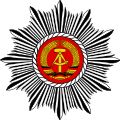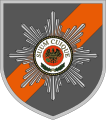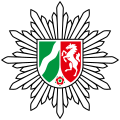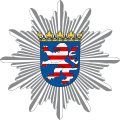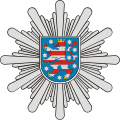Police star
The police star is a symbol of various police forces , in Germany for example the state police , the federal police , the Federal Criminal Police Office , the police at the German Bundestag and the military police . It is a legally protected national emblem ; abuse is a criminal offense in Germany ( badge abuse ).
History of the police star as a hat emblem
The police star goes back to the history of the Prussian order. On January 17, 1701, Frederick I - here still Elector of Brandenburg - founded the Black Eagle Order with the inscription Suum Cuique , d. H. To each his own . It is the short form of Frederick I's personal motto: Justice is recognized by the fact that it gives everyone their own . This order was worn in the form of a collar or a blue enameled Maltese cross on a sash as an eight-pointed breast star .
Before and during the Silesian Wars , Frederick II - later called Frederick the Great - ordered the military corps to be set up on horseback. The selection for this field hunter corps fell as a rule on forest officials because they had a special relationship of loyalty to the king and were excellent at handling the "rifle with a rifled barrel". On February 6, 1741, Frederick II awarded the Reitenden Feldjägercorps the Guard Star for special services.
After the end of the wars in 1763, Prussia was effectively bankrupt and had to dismiss a large number of servants. A large part of the field hunters could no longer be accepted into the forest service and were thus accommodated in the rural gendarmerie at that time . The former police officers kept the awarded guard star as a hat badge as a distinguishing mark.
The first police association to wear the star as an additional helmet emblem was the Prussian gendarmerie . Around 1781/82, the Berlin police were uniformly uniformed for the first time and the different ranks were identified. The headgear was adorned in a reduced form of the guard star with the Prussian eagle.
In 1895, the German Emperor Wilhelm II awarded the members of the gendarmerie brigades the silver guard star as an additional helmet emblem with the "highest cabinet order ". This was thus introduced by law, so that the foot gendarmes also wore the guard star on their black shako. This star was taken over by the police of the Free State of Prussia after the First World War . According to the Versailles peace treaty , all gendarmerie units of the police were slammed and now belonged to the area of the interior ministries of the states of the Weimar Republic, founded in 1919 .
After the Second World War , the former Prussian police chief was introduced as a uniform badge for the service hats and shakos of the German police, each with the national coat of arms and the country's color on the star. After the shakos had been taken out of service by the individual state police towards the end of the 1960s, a correspondingly reduced star, usually made of tinplate or aluminum, was attached to the service hats.
With the introduction of the uniform police uniform ( 1974 ) in the Federal Republic of Germany, the hat star was also modified and standardized. An old gold star was introduced with the respective national coat of arms of the state police in the middle in the appropriate color. He is still on the bonnet, on letterhead and uniformed vehicles of police and the military police of the armed forces used. Since many police organizations around the world were built based on the Prussian model, the guard star was also often adopted as a recognition symbol for the police in some country-specific form. In some countries, for example in Finland , the guard star has mutated into a symbol of the fire department .
Various German police stars
Prussian guard star with the motto Suum cuique
Police officers of the German People's Police
Current police officer of the federal police
Internal association badge of the military police command of the Bundeswehr
Current police officer of the Schleswig-Holstein police
Current Police Star of the Mecklenburg-Western Pomerania Police
Current police officer of the Hamburg police
Current police officer of the Bremen police
Police officers of the Berlin police
Current police officer of the Brandenburg police
Current police officer of the Lower Saxony police
Current police star of the North Rhine-Westphalia police force
Current police officer of the Saxony police
Current police officer of the Saxony-Anhalt police
Current police officer of the Hessen police
Current police officer of the Thuringia police
Current police star of the Saarland police
Current police officer of the Rhineland-Palatinate police
Current Police Star Police Baden-Württemberg
Current police officer of the Bavarian police
United States
Sheriff Jefferson County, AL (Personalized)
Sheriffs and their officers with police duties wear a sheriff's badge on their chest, which is designed differently everywhere.

